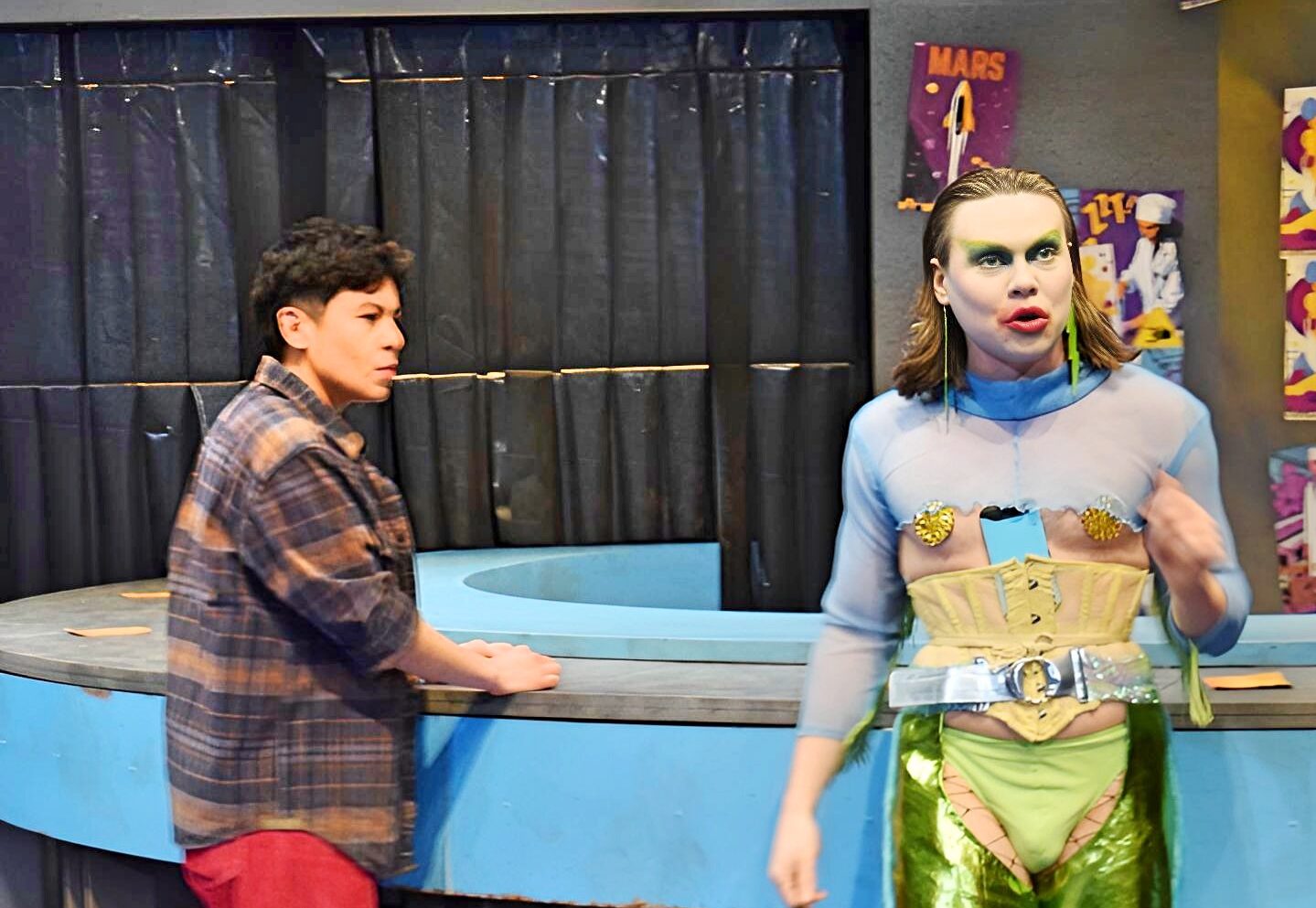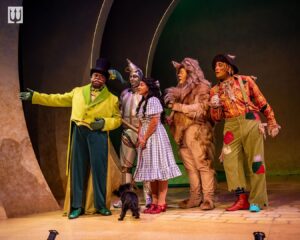
Elm Reyes and Wayne Burns
In Breton Lalama’s new play The LAST SHOW ON EARTH ™!, which opens tonight, Friday February 9, 2024 at the Neptune Theatre‘s Scotiabank Stage, the characters are counting down until the last day of life possible on planet Earth.
Set in an Apocalyptic future, or perhaps an Apocalyptic present, this play follows the journey of Eli, a quiet character played by Elm Reyes, who is an essential worker at a fruit roll up factory struggling with feelings of grief, while also trying to save up enough money to buy a black market Fleedom Ticket to Mars to ride out the catastrophe. Lina, played by Anne-Marie Saheb, is a wealthy business owner, and while she has the money to flee, she has instead chosen to stay because she doesn’t want to abandon the business that her family has worked so hard to build, and the life that she knows on Earth. Ayo, played by Wayne Burns, is a famous influencer who has become the star of The Last Show on Earth ™️, the person who is set to herald in the End of the World, and to host this most unique event in our planet’s history.
I sat down with Reyes, Saheb, and Burns at Neptune Theatre to chat about the show, which feels incredibly relevant to our lives as we are coming out of a Global Pandemic (a collective unprocessed trauma), with a war in Ukraine, genocide in the Middle East, a global rise in Fascism, Anti-Semitism, Transphobia, Populism, and Islamaphobia, with the cost of living and groceries soaring, the homeless being evicted from their tents here in Halifax, and a housing crisis that seems nowhere near securing tangible solutions. I wondered from the description of the play if it might be a bit too timely for audiences that seem to be gravitating more toward lighter and cozier fare as a reprieve from the reality we’re all forced to live in. I was assured by the cast, however, that, despite the heavy conceit of the show, Lalama has written this play as a dark comedy. Burns, who is dressed akin to what you might expect of a futuristic Club Kid from Frank N’ Furter’s Transylvania, stresses that the show is very funny, playful, kooky, and joyfully Queer, complete with a fruit roll up strip tease and “hairy butts.” He laughs.
Each of the three characters depict a different response to the reality of the end of their lives, and the end of everything that they know. Eli encapsulates a meme that I remember seeing in the early days of Covid about how absurd it is to have to work right up until the end because living in the wake of the apocalypse is surprisingly expensive. He is an essential worker, so he keeps getting up, and going to work, as that is not just his familiar routine, it’s also his role in society. Eli and Ayo used to perform together, and seeing Ayo’s face everywhere as the poster child of the Apocalypse begins to have a vivid effect on his psyche. As Burns puts it, Ayo, in a way, isn’t just heralding in the end of the world, they’re heralding in the specific death of Eli as well.
Lina, however, because of her wealth, is afforded the luxury of choice. She is able to choose whether she wants to leave for the promise of a brand new society (and all the problems that might arise there), or remain to ride out the end in the place she calls home. This provides her with a more fatalistic calm, and perhaps even a comfort in the knowledge that, as Saheb says, nothing matters anymore. As a business owner left on Earth in this situation, Lina is also profiting economically from remaining here, ensuring that she will keep getting richer to the very end. Ayo is determined to dance their way out- to go out with a bang, and to make the absolute most of this situation and run with it. Burns says Ayo makes a costume out of garbage and tries to be as glamorous as possible under the circumstances.
The cast reference the film Blade Runner (1982), as well as Samuel Beckett’s play Endgame (1957) and even Tom Stoppard’s Rosencrantz and Guildenstern Are Dead (1966), which is playing at Fountain Hall next door, as works exploring similar themes or pondering similar questions. Burns says that he thinks Artistic Director Jeremy Webb programmed the two shows with a sense that they complement one another thematically, stressing that the difference is that Lalama is looking at these same ideas about choice, death, and how we make the most of the time that we are given, through a much queerer lens.
Like Rosencrantz and Guildenstern Are Dead, though, which is extremely funny on the surface, but ultimately contains quite sobering themes, Burns says that for all its silliness, citing the different allusions to fruit roll ups, if you dig underneath the sweetness of The LAST SHOW ON EARTH ™ you’ll find something really delicious and nourishing.
Annie Valentina directs the World Premiere of Breton Lalama’s The LAST SHOW ON EARTH ™, which plays at Neptune Theatre’s Scotiabank Studio Theatre (1589 Argyle Street, Halifax) until February 18th, 2024. Shows run Tuesday to Friday at 7:30pm and Saturday and Sunday at both 2:00pm and 7:30pm. Tickets range in price from $23.00 to $40.00 based on seating. For tickets please visit this website, call the Box Office at 902.429.7070, or visit in person at 1589-93 Argyle Street.
This show is estimated at 75 minutes (no intermission).
Babes in arms & children under 4 are not permitted in the theatre.
Please note: this show contains transphobia, homophobia, racism, suicide, strobe lights, theatrical haze, and simulated sex.
KEY DATES
SUPPORT FOR CULTURE
INDUSTRY NIGHT:
Tuesday, Feruary 13 – 7:30 pm
TALK BACK NIGHT:
Thursday, February 15 – 7:30 pm
MASKED PERFORMANCES:
Sunday, February 11 – 2:00 pm & 7:30 pm
Neptune Theatre is fully accessible for wheelchair users. For more Accessibility Information Click Here.









1 thought on “The Biggest End of the World Show Comes to Neptune Theatre”
Comments are closed.